If you’re thinking about camping in the new Jimny here’s everything I’ve learnt so far. This is all based on real life camping experiences. I’ll update the guide as I try new things and hope it helps you 🙂
We bought the Jimny to have a small daily driver that was capable of being adapted to an off road micro camper. Convenience, comfort and maintaining the drivability of the Jimny are all key factors in achieving the best set up. Of course doing so at reasonable cost is important too.
I’m not linked to any company mentioned in this guide. I’ve bought everything in full with my own money.
The guide is in 6 sections.
Car camping in the Jimny
I’ve written an article dedicated to sleeping in the Jimny. It’s great fun and you don’t need to spend a lot of money to try it for yourself. Here’s video to help you decide if you want to try it.
Roof top tent
A roof tent was always our goal for the Jimny.
Back in 2019 we originally bought the lightest weight roof tent we could find within our budget. This was the Front Runner Roof Tent. It’s decent tent even though it’s one of the cheaper ones on the market. Coming in at 43kg, it’s one of the lightest too.
I’ve seen other Jimnys with heavier tents so it shows what can be done.
We were happy with the tent we had as it’s a good balance of weight, convenience and comfort. However I did build my made my own DIY roof tent. The goal was to make my dream tent and keep it super lightweight.
It was quite a daunting project but I did manage build something I thought (at the time) was the answer…a 42kg DIY hardshell roof tent!
Long story short… I ended up dismantling the DIY tent as it failed in a few key ways. Too much condensation, the tent material design wasn’t perfect and it suffered water ingress while packed away and a few other issues. In hindsight, I should have made it bigger instead of trying to build the lightest weight roof tent ever (this has now been done commercially, i.e. properly by Inspired Overland). At the time I think a 42kg hardshell roof tent was a record.
Subscribe
Get our monthly email, Out There Life for latest interviews, blogs, camp stories, gear tips & guides, new products and more… straight to your inbox.
Register freeAnyhow, I am now running the tent that got me into this whole Jimny and camping scene in the first place. The iKamper Skycap mini.
For us it’s the perfect set up. The shape when deployed is just better than a wedge style, especially when you’re 6 foot tall like me. I’m not a big guy but unless the wedge tent is very long, which will then overhang a lot on the Jimny roof, you’re going to feel cramped. In the iKamper we can both sit upright and have enough space to even sit and play cards or whatever you do after 18 years of marriage.
I would love it if iKamper brought out a lighter weight mini without sacrificing the quality and comfort of the current version. Until then I have no intention of changing the tent and will accept the extra roof load which is actually not proving to be an issue after all.
Roof load – How much weight is on the roof while driving
The elephant in the room before we start is roof load limits. How much weight the car can carry on the roof, including the fixtures and fittings.
Less is more has never been more relevant a phrase when it comes to roof load on a Jimny.
The owners manual does not list a roof load limit. The official Suzuki roof load bars are rated to 30kg, and this seems to be the load limit consensus. Some dealerships have quoted 40kg limit many say 30kg.
I personally believe the limit listed on websites and quoted by Suzuki staff is carried over from the previous generation Jimny that has plastic mounts in the roof which limited its ability to bare weight. Please don’t take this opinion as fact. It’s a touchy subject for some owners and if you decide to exceed the 30-40kg suggested limit you’re doing so at your own risk.
If you’re planning to do proper off-roading I would not recommend doing so with a roof tent on. By this I mean the kind of off-roading our friends is Australia do for example. For someone like me, who simply drives the occasional off camber track and dirt road to get to camp it’s a non issue, on 1 condition. I strongly believe you should not put a roof tent on stock Jimny suspension. Upgrade that first, then worry about what tent you buy.
The generation 4 Jimny has strong rain gutters when combined with a quality rack system you can load a decent amount of static weight. We’ve had upwards of 220kg static weight (not while driving obviously).
The more weight and height you add to the roof the worse and less safe it will be to drive the vehicle. The stiffer suspension from an upgrade (doesn’t need to be lifted if you don’t need the extra clearance) will go a long way to alleviate the body roll and white knuckle ride that it is driving a Jimny on stock suspension.
Reality check
It’s no secret I, and 100’s of other Jinmy owners are exceeding the load limit and the Jimny is not supposed to be used in this way. Make sure you set up allows for it, stiffer suspension and get rid of the stock tyres too, they’re too flexy.
As of today my opinion has changed somewhat since first getting the car, I’ve owned it for 6 years as of writing this and have had 3 different tents on it. My total roof load started at 44kg, then around 60kg and is now around 75kg (sometimes less). Please do not do what I’m doing without having your Jimny ready for it and adjusting your driving style to get used to how your car handles with load on the roof.
All I’m doing in this guide is passing on my own experiences. Therefore, take what I say here with caution and do your own tests to discover what is best for you and what you’re comfortable with.
A good rule of thumb is to store anything of weight inside the vehicle to keep the centre of balance lower to the ground. If you’re insistent on roof tent camping as I am, and I’m yet to find a set up I like more, then read on but please take roof weight seriously.
Mounting position
Side mounted or rear mounted?
Front Runner – Clamshell Folding Style tent
Side mounting seems to be a more popular method of fixing a roof tent to vehicles. We decided to buck the trend and mount Front Runner the tent off the rear. Here’s why.
- To create shelter over the rear door.
- The width of the tent in this position sits well on the Jimny.
- Airflow is better when driving with the ladder stretching down the car not across it (even better if you remove it).
- It allows for an awning on either side of the Jimny (bonus, you can then connect it to the tent to create a superb batwing style shelter).
We mount the tent so the back edge is in line with the end of the roof. This is to allow space to open the door without it hitting the ladder.
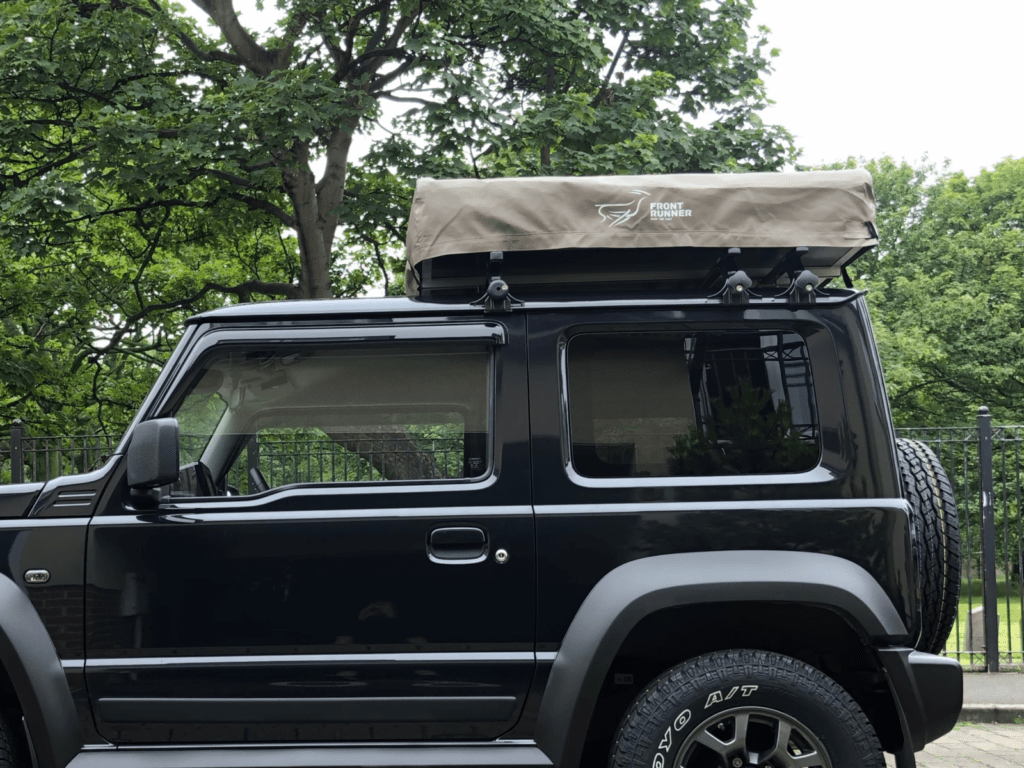
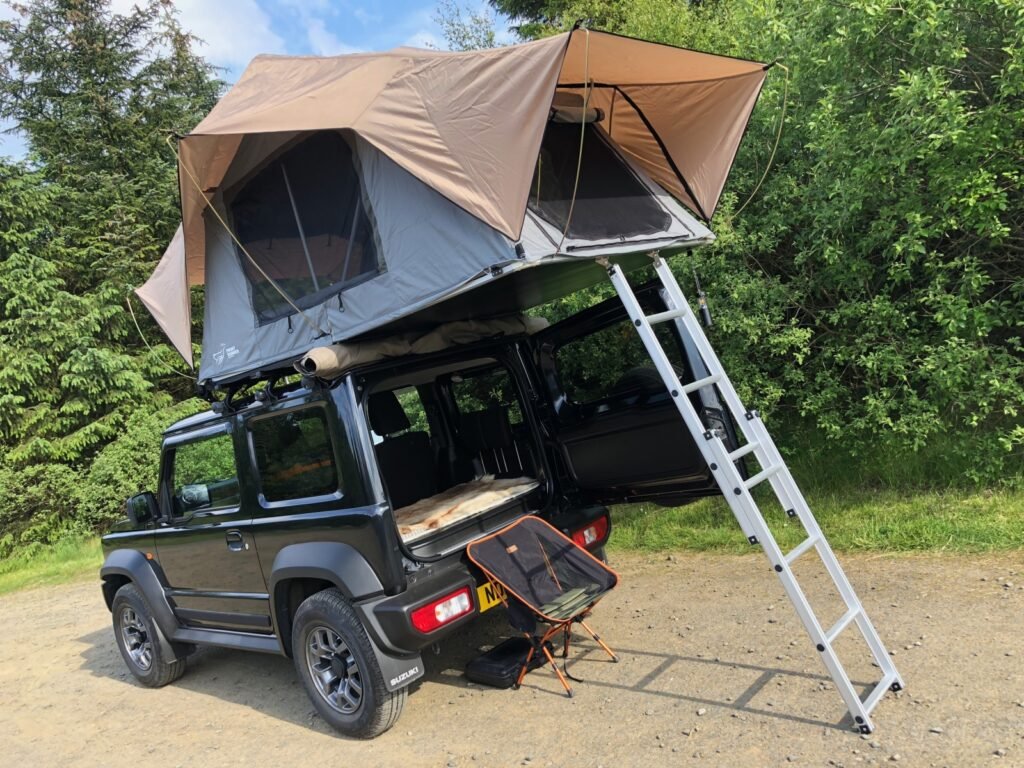
Another cool feature is the tent cover will roll up neatly and slot into the space between the roof and the tent. Most people I’ve watched set up their tents remove the cover and store it in the car. I’m not a fan of that for 2 reasons, firstly it can dirty and wet and secondly you’re working with limited space in a Jimny.
Be careful to fold it around the aerial without damaging it. You can remove the aerial but I’ve not found it a problem.
iKamper Skycamp Mini
The iKamper Skycap Mini mounted on a Jimny will always open off the right hand side of the vehicle. For us brits that is on the drivers side.
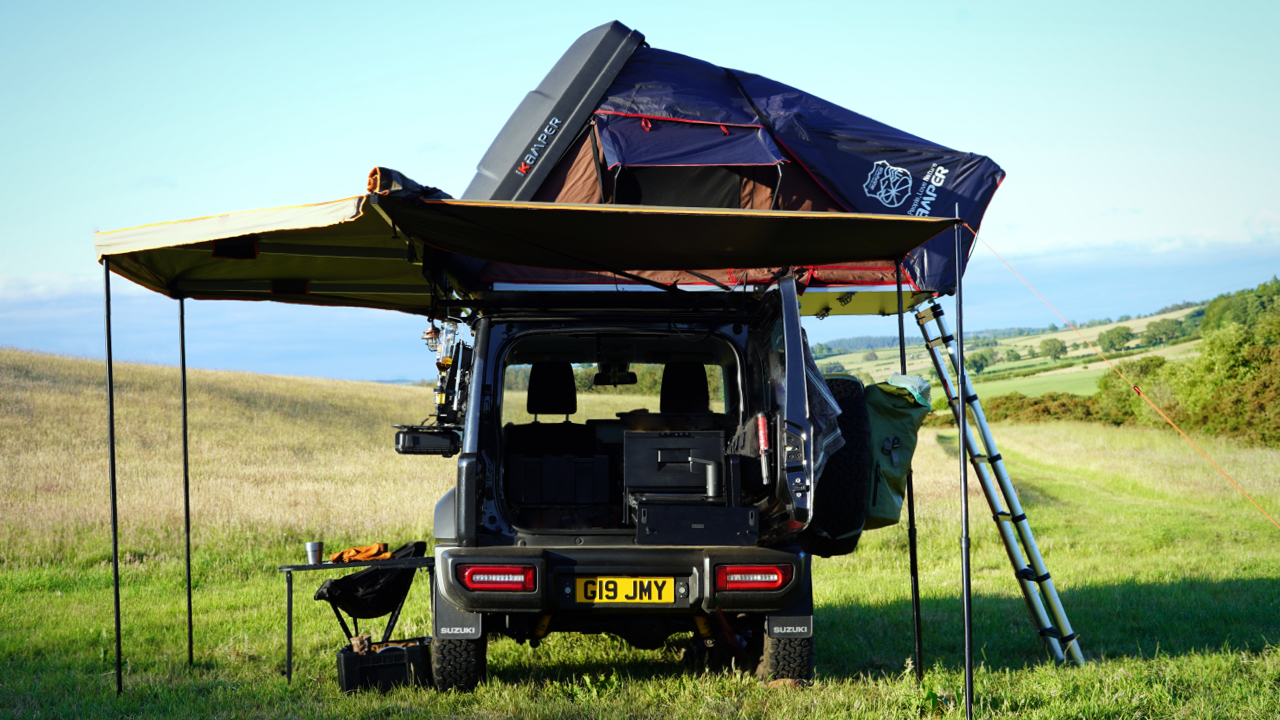
I’ve spent a lot of time refining this set up and it works extremely well for my wife and I.
Load bars
Our first setup was the Thule Squarebars and the low profile 150cm feet.
Unfortunately, for 2 people sleeping in the tent 2 bars didn’t feel strong enough and they sagged in the middle. We collectively weigh 150 kg and the bars are rated to 100kg. So we added a 3rd bar to help support where the main weight is distributed.
This was much better. The setup and positioning above is recommended if you go for 100kg rated load bars with 2 people sleeping in the tent.
This set up uses 2 front runner load bars. There are many good quality load bars on the market and I can only give my opinion on ones I’ve used. They’re super strong and the feet sit great in the Jimny’s rain gutters.
Front Runner recommend that you use their tent brackets to mount onto the load bars. Personally I would save your money and use the metal brackets that come with the tent. Or do what I did and drill holes directly into the slats for the tent bolts to drop into.
I now use 3 Front Runner load bars with my iKamper set up and this works very well. In recent times Jimny specific load bars made by Skinny Jim are also a good choice. Although I haven’t used them myself I’ve talked to many people who are very happy with their purchase.
Full rack
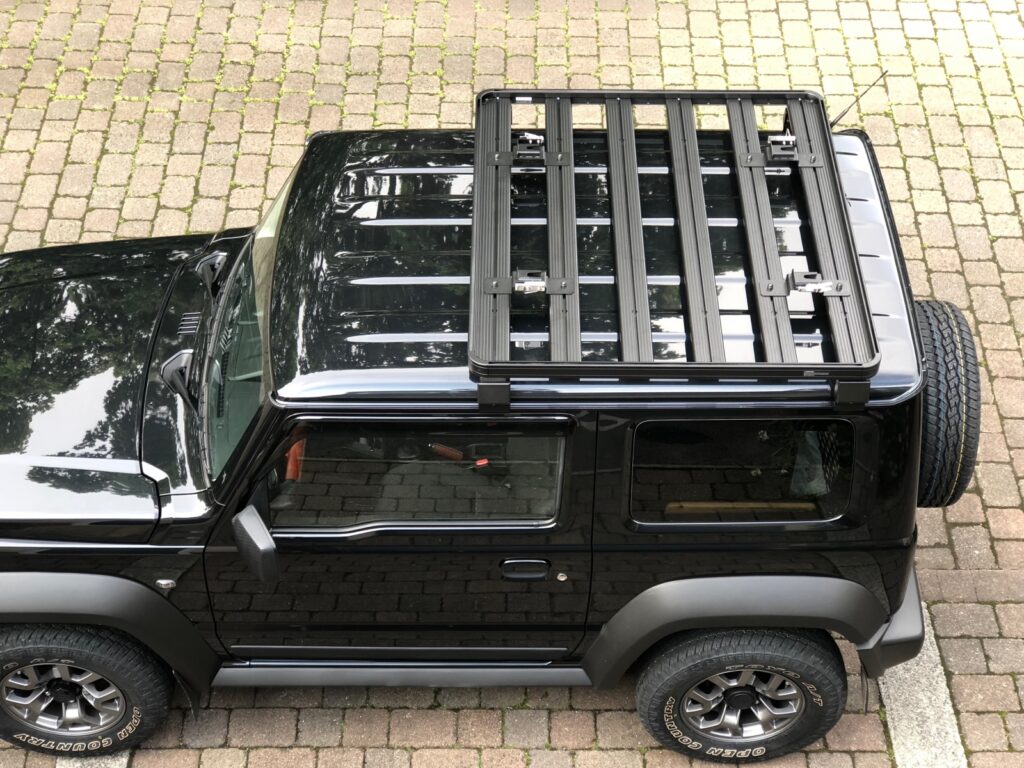
We tried the Front Runner Slimline II 3/4 rather than the full sized rack to save weight. Initially we liked the idea of being able to have modular rack system to mount other things when we’re not using the tent too.
However, we removed the Slimline II rack and are running with the load bars only. I realised that part of my purchasing decision was (ashamedly) for how it looked. I’d convinced myself we would use the rack when the tent wasn’t on but that’s never been the case. So I swallowed my pride, accepted it was a vanity purchase and switched to the load bars only.
Regardless, the rack is great if you need one. It weighs 22 kg so it’s quite lightweight and the full rack runs at 27kg. For reference the measurement from the ground to the top of the rack when mounted on a Jimny is 69 inches (1755mm).
If you go with the Front Runner tent brackets they sit within the rack height when the tent is removed and the tent lies flush with the top of the rack when mounted. Total load with the 3/4 rack and tent is 65kg.
What’s it like to drive?
In my opinion the road manners of the Jimny are okay with less than 60kg load on the roof with stock suspension. This is purely from personal experience. Plenty of Jimny owners are driving (and off-roading) with more roof load than that but I couldn’t recommend it. With upgraded suspension upwards of 80kg feels ok to me as long as you drive sensible and don’t do any challenging off-road tracks.
I love tweaking my set up over the years and with our old ultralight setup it’s hardly noticeable that there’s a tent on the Jimny (excluding serious off-roading conditions). This might be because I’m used to it. I prefer to run as light as possible, but it’s your call. Regardless of what you decide, you ought to adapt your driving style to the conditions and weight you’re carrying.
- We don’t speed down the motorways.
- We increase our stopping distances.
- We take corners at a sensible pace.
- We try to balance weight evenly in the boot space.
We prefer to drive between 60-65 mph (96-105 kph) for longer distances. Just sit and chill on the inside lane.
On a trip with longer distances the SZ5 UK spec Automatic gives us approximately 30 mpg. Without the camper set up on we get a few more mpg but honestly at this point I can’t see what would improve that unless I took the all terrain tyres off.
With the 40L tank I’m glad there’s petrol stations littering the UK as it feels like you’re always filling up!
I actually prefer driving the Jimny with 2 passengers and the roof tent on. Because it feel less ‘kite like’ in high winds and more solid on its feet.
What’s it like off-road?
I’m super impressed with the Jimny off road even with the tent on. You can see that on moderate terrain the Jimny eats it up. Be to clear I’m not an experienced off-road driver. There’s different levels of what people class as off-road driving. My use is towards the very mild side of the spectrum. With the tent on and a decent amount of equipment in the back it feels ok to me.
Watch some action from a trip in the Yorkshire Dales.
What it’s like to sleep in a roof tent?
Simply put, it’s awesome.
It’s giving us the best night sleep we’ve ever had camping (depending on how drunk you get) and it’s easy to set up.
The Front Runner tent takes approximately 5 minutes once you get the hang of it. With 2 people it’s quicker. Granted, it’s not 60 seconds like iKamper but it’s not terrible to setup. We’ve done a lot overnight trips and it was worth every penny.
Here’s my favourite camping trips with the Front Runner Tent.
Here’s my current iKamper tent set up
Awning
Subscribe
Get our monthly email, Out There Life for latest interviews, blogs, camp stories, gear tips & guides, new products and more… straight to your inbox.
Register freeIf you’re willing to add a more weight you can choose to add an awning. I debated this decision for a while before getting one. My main concern is always additional weight and the benefit of the item. I’m so glad we did though as we are surprised how good it is in practice.
At first we went with the Darche Eclipse 1.4m awning from Trekoverland.com.

The reason we chose 1.4m was its low weight (8 kg) and it’s just big enough for our needs. You could easily decide to go for something longer but this awning is ok for us. A 1.6m would fit perfectly across the length of the Jimny roof if you want to take advantage of the full length of the roof and line it all up. Obviously 2.0m awnings will have overhang.
We mounted it on the passenger side, aligning it with the back of the tent. It’s awesome and looks great on the car. Especially with the black front runner tent cover to match it all together. The awning is mounted to a rack or load bars with the 2 brackets that come with the awning.

Darche Eclipse 180 Degree Rear Awning
I’ve replaced the 1.4m awning with a Darche Eclipse 180 Rear awning to offer us more length in exchange for some extra roof weight. This awning provides full clearance to open the passenger door. The 1.4m awning restricted this a small amount. We also on occasion take the wall set to create a huge enclosed space.
At times we have mounted it off the rear as seen below.
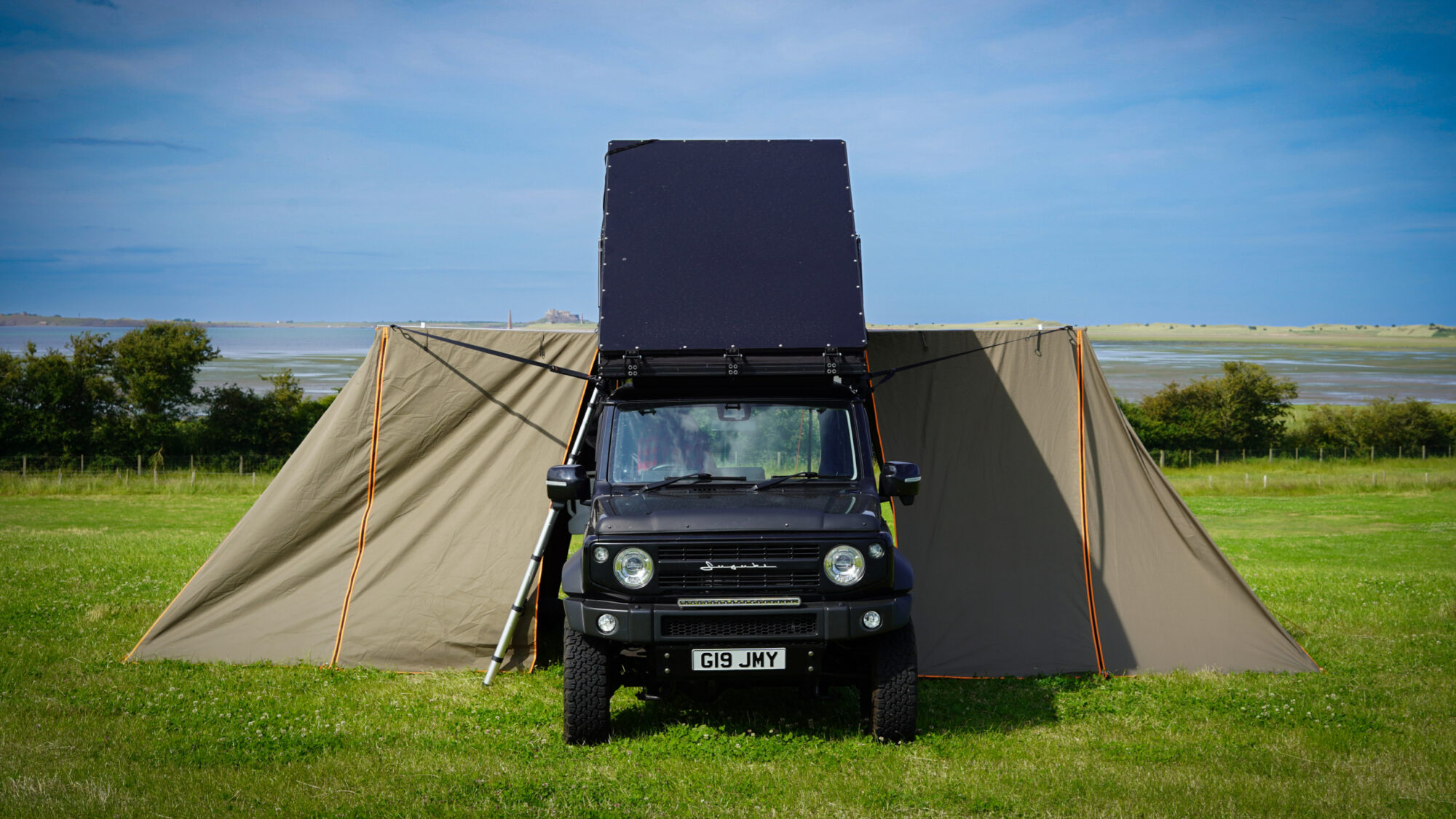
However, mostly we side mount it to allow for a more flexible set up. We can drop one wall to provide some wind coverage like this…
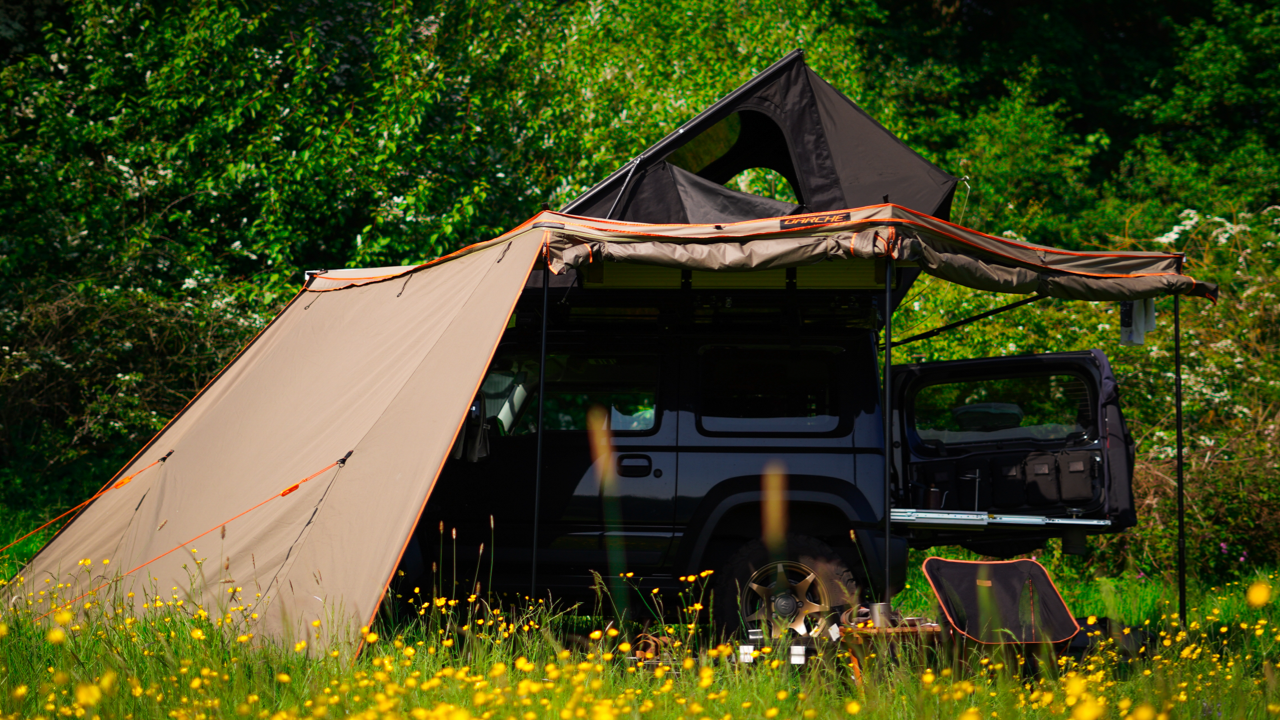
Or the full coverage like this.
Recommendations
This might sound like overkill and yes I’m a weight nerd.
Always consider is how to reduce the roof weight and overall payload, every kg counts. Second is improving aerodynamics. Finally, we’ll look at quality of life improvements, what we can do to make the setup quicker or more comfortable.
Reducing the roof weight
It’s easy to reduce the tent weight from 43 kg to 37 kg. Follow the modifications in my article for creating an Ultralight Roof Tent set up. The main element to reducing weight is the ladder. Similar can be done with other tents on the market like there iKamper tent I now use. I keep the ladder in the car and added some quick release pins. I’ve timestamped the video below to demonstrate this…
Upgrading the ladder
Roof tent telescopic ladders are hard to find in the UK so I modified a 2.6m telescopic ladder I ordered from Amazon. It was a lot cheaper than the telescopic tent ladders I’ve seen online. How the ladder is fitted is detailed in this article.
These ladder greatly improves upon the one you get with the tent. They’re wider, easier to use and more sturdy.

Reducing the weight of a full rack
This is an easy task, simply remove any slats that aren’t used under the tent. You don’t need them and in the case of the front runner 3/4 rack it reduces the weight to from 22kg to 18kg.

Aerodynamics & wind noise
Depending upon what rack or load bars you choose you may have whistling and annoying wind noise.
With the front runner rack we had awful whistling over 20 mph. It sounds like a boiling kettle and isn’t much fun on a trip. Choose to either mount a proper wind deflector or try to close the gap between the tent and the rack. This should eliminate the noise.
When we ordered the rack we were sent the wrong sized wind deflector that mounts below the rack at the front. I wondered if mounting it to the top of the rack at the front, upside down would stop the whistling. As luck would have it, it worked!
It may require some trial and error but these little touches really increase the pleasure factor on longer trips.
Note that you get zero wind noise when mounting the tent directly onto the load bars either Thule or Front Runner load bars.
Running only roof load bars
If all you plan to store on the roof is a roof tent then it’s crazy to use the full racks. Instead just use a strong set of load bars.
A more comfortable tent mattress
The standard mattress in the Front Runner tent is okay and many roof tents adopt the same 2″ foam mattress concept. Unfortunately we were waking up multiple times during the night with sore hips. They’re not very warm either as no insulation is factored in.
You can’t underestimate how much difference a comfortable, insulated mattress makes. I’ve written an article about sleeping in the Jimny and the 2 mattresses we use for that set up are the same ones we use in our tent.
Here’s what they look like in action. Being essentially expedition style inflatable mattresses, they’re warm and mega comfy. With ear plugs to block out any noises we get a far better nights sleep than we did with the tent mattress.


Modifying the awning
If you decide to mount your tent off the rear of the Jimny and want a side awning too, this tip worth considering.
I had an idea to create a bridge between the side of the awning and the tent. I’ve written an article on creating a custom awning extension to achieve this. This was a fun project and I’m astonished it actually worked. I’ve since remade the first prototype out of matching material to the awning.
In heavy rain the extra coverage makes a big difference. A 1.4m awning may be small but with this extension it’s ideal for keeping us dry when moving from the side to the rear of the Jimny. Extending the longest end to 2.7m!



Old build that used a tent you can buy
The video shows the tent and bars only, that’s why it says at 44kg. We add 8kg with the awning, bringing the total roof load to 52kg.
Set up demo for Front Runner tent
Final thoughts
Sleeping in a roof tent or inside a car is something you need to get used to. This might sound weird, but you get less broken sleep as you become more accustomed to it. Don’t forget your ear plugs!
Subscribe
Get our monthly email, Out There Life for latest interviews, blogs, camp stories, gear tips & guides, new products and more… straight to your inbox.
Register freeMy advice would definitely be to try sleeping in the Jimny first as it’s the cheapest way to get out enjoying an adventure. It’s a good fun and the perfect solution in really bad weather.
If you’re willing to invest into your Jimny camping experience and can justify the cost, we wholeheartedly recommend a roof top tent. Several trips per year ought to justify the expense.
I hope this guide has helped you in your future Jimny adventures. I’ll try answer any questions you have so feel free to comment below.

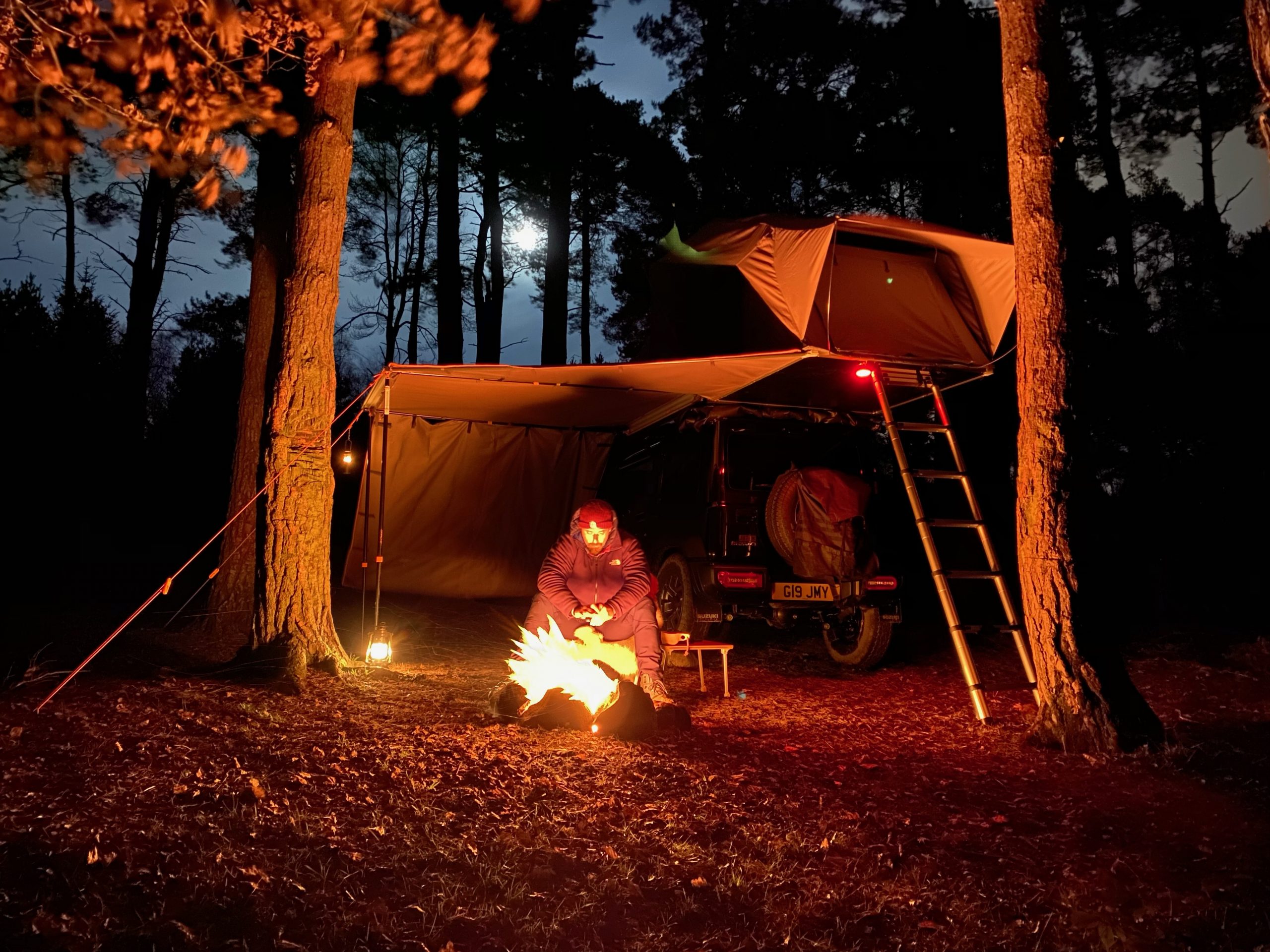




Awesome piece – thanks very much for putting it all down…
After nearly a years wait my Jimny arrives in a week or so!
Cheers.
Gareth
Cheers Gareth, glad you got hold of one mate ??
Hi
Great website with lots of excellent information. A quick question. In order to sleep in the Jimny, did you remove the rear seats ? It’s not clear from the photos and I couldn’t find any modifications on the website.
Thanks
Scott
Hi Scott, cheers mate appreciate it!
Here’s a video of me setting up the Jimny for 1 person to sleep in it. If you’re bored you can watch a video of me setting it up at a recent overnight camp. Slept like a baby 🙂
There’s also a full guide for sleeping in the Jinmy here.
Hi Geordie Jimny, thanks for your website with all the information about “Jimny Camping”.
About the roof load question. I bought an old Jimny used a couple of weeks ago, according to the swiss registration the roof load is 50Kg, the same applies to the new Jimny. Suzuki also gives the maximum roof load in Switzerland directly in the brochure.
https://www.suzukiautomobile.ch/fileadmin/media/pdf/cars/pricelists/PoP_Pricing_Jimny.de.pdf Last page under “Maximale Dachlast”.
Interesting! I’ve only seen 30kg quoted but that certainly makes sense. I still exceed that limit at 52kg but it handles it very well. Thanks for the info Philippe.
This is by far the best information regarding camping on a Jimmy I have ever seen. Thank you and congratulations ‼️?
Thanks Francisco, glad you found it useful.
Hello, the legal roof load in South Africa for the new/Gen4 Jimny 1.5 is 75kg. Great website Geordie.
Really? Well that has changed their stance considerably. Cheers for letting me know Christo ?
Hi! I love this article, thank you.
Quick question. I’m just worried about let’s say, if you’re in an accident and you have e.g. 60kg on the top of the Jimny (which would exceed the recommended weight of 30kg), what would your (or mine) insurance company say in terms of – if they were trying to blame the accident based on the Jimny being too overloaded, which could affect the brake capacity. I’m just curious as I’d like to do the same set-up for mine, however I don’t want to drive around paying for insurance, but then having them turn around and decide not to cover me if anything would happen. Would they actually measure this is maybe more the question. Thanks in advance! 🙂
Hey Malin, short answer is I don’t know and it would depend upon the insurance company. I run the lightest roof tent setup I’ve seen and handles great.
There’s also reports of different official load limits. I’ve seen 30, 35, 40 & 75 stated from people in different countries. Myself I prefer less than 60kg on the roof but many run with more.
It’s all done at the owners risk of course. I hope my articles make this clear?. Definitely a case of don’t do as I do and stick with what makes you most comfortable. I try to share in detail what I’ve tried and am happy with results wise.
Cheers
Hi Geordie
what a great article, well done.
I have a dilemma , do I use Thule roof racks and add three for future use of a tent, and for my kayak or for convenience and looks add a full front runner?
I am ver confused
I ended up removing the front runner rack and just using the load bars that formed part of the kit. If I were to store boxes and other items on the roof the racks are great but they’re useless excess weight if just mounting a tent on as I do. I guess you would get good use out of a full rack too as you’re planning on mounting different items to me. They look better and are stronger but obviously the cost is dramatically higher for Front Runner.
I was starting to feel alone as a weight nerd! Thank you for writing this!
I’ll not lie… I’ve gotten worse recently haha. Need to update my guide soon. Added some weight but been working hard to reduce other item weight to get overall payload as low as possible 🙂
Hi Geordie,
I want to thank you so much for this blog, it has really helped me customize my Jimny smarter! In addition I want to ask you about the tires of your choice, the Toyo Open Country A/T. What advantages do you consider it has in comparison with other brands? I have been looking to upgrade as well and I have heard good things about the BFG KO2s.
Also, regarding your video ”Ultralight 44kg Jimny Roof Tent Set Up”. In second 0:22 looks like the antenna is little bit bent over by the load bar. This can be fixed by just sliding the load bar forward, right? I wouldn’t want for it to break, or is it flexible enough?
Again, thank you so much for this great article.
Cheers!
Hi Rodrigo, thanks mate, glad the blogs help 🙂
The toyos are a lighter weight tyre with a less aggressive tread than the KO2s so more fuel efficient and better on road. I don’t do a lot of off roading hence why I chose those tyres instead. They’ve been more than ample off road for my usage needs.
For the antenna, yes the stock one does bend with the roof tent on. I’ve since replaced it with a shorter one. The tent needs to be positioned that far back so the ladder clears the rear door when it’s open. If you don’t use a roof tent then the load bars won’t cause any issues with it.
Cheers Paul
Awesome awesome awesome blog/site!! Getting my GLX Auto in 2 weeks!
I’ll be using so much of your information.
Sorry to see the UK is without new Jimnys due to the ban 🙁
Francois – South Africa
Thanks buddy! Sorry it took so long to reply. Congrats on your new Jimny. There’s reports the new commercial Jimny is coming so all is not lost in the UK 🙂
Thank you for setting up so many useful information about the Jimny and its camping features!
I actually drive a Suzuki Ignis with a rooftop tent from Gentletent (GT Roof). With 25kg it is the lightest tent with the smallest packing size (100x100x15 cm) – so if you really insist on saving weight on your roof this is the tent to consider 🙂
I will thoroughly inspect the new Jimny Country as soon as it becomes available here in Switzerland.
Cheers – Simone
Hi Simone, thanks and glad the website helps.
It’s really weird, I drove an Ignis today for the first time as a courtesy car as the Jimny was in for it’s 2nd year service. Really like them and would be cool to have the hybrid one.
I’ve seen those tents too and pretty cool concept. I’ve got some plans to try and lower the weight of the front runner tent even more and it’ll help save some cash than buying something new 🙂
Fingers crossed it’ll work out.
Best wishes
Paul
Hi There,
Was keen to get your thoughts on mounting this tent and awning set-up using the Suzuki Jimny stock roof racks?
Best,
-K
Hello Kai, they’re only rated to 30kg so definitely not strong enough unfortunately.
Cheers Paul
Hi There,
Ever considered installing a Yakima EXO hitch system for increasing storage space? Seems like a plausible alternative to a trailer. They have quite a few attachments for cargo, bicycles, table tops and racks.
Not sure if the Jimny can handle the load?
Cheers JK
Hi Jonny, The Jimny can tow 350kg unbraked so it’ll be fine with the Yakima EXO Hitch. Certainly a stronger setup to loading up the spare wheel mount. 🙂
Hi Geordie Jimny,
First of all, I am a fan of your youtube channel and enjoyed watching the videos you filmed. This is a very helpful article for me, who is going to own a Jimny soon 🙂 I have ordered a Jimny and it’s aimed to arrive within 2 months or so. So I have been thinking what kind of setup do I need. So I have a question and thinking you might have any thoughts for me.
I am looking for an awning that fits Jimny with only build-in suspension set and 2 strong cross bars. There won’t be a roof tent as I am planning to sleep inside Jimny. Thinking to get 270 degree free standing awning but worry about the weight on 1 side of Jimny may affect driving experience. My question is what is the weight limit of an awning that you think it’s not gonna affect my driving experience?
Any advices would be appreciated. Thanks in advance.
Howard
Hi Howard. Thanks man, glad you like the vids 🙂
I’ve had 2 Darche awnings and really like the quality of them. The 180° weights 13kg and the 270° https://www.trekoverland.com/products/eclipse-270-awning-uk-drivers-side-awning-darche-t050801745d is 27.5kg. Add your load bars that are approximately 5-7kg most likely and you’re fine weight wise on stock suspension. There’s the 20.5kg 270° awning called Kozi too https://www.trekoverland.com/products/kozi-270-vehicle-awning-darche-ksa2000 I’ve not seen it in person though. Talk to Clare at trek overland she’s great!
As always I would recommend the lightest kit you can find for the roof. Caosgear in Australia have just launched a 14kg 27° awning too and I believe this is the lightest weight on the market! Here it is on the little rig https://caosgear.com.au/collections/awnings/products/nomad-premium-270-awning-jeep-suzuki
Hope this helps, whatever you go for if you’re only putting the awning on there you’ll be fine mate.
If load potential is approximately 40kg how is it able to take the weight of tent and roughly 150kg of two people sleeping inside?
Hi, that’s dynamic load not static. Static hold a lot of weight. While driving 30-40kg seems to be the manufacturer limit however most owners exceed this at their own risk.
Best Jimny article i have read thus far! And i have read alot.
thank you for your time and effort
Hi Geordie. Great article. Plenty of useful insights and tips. Any thoughts on fridges/batteries/panels etc? And general camping equipment. In terms of Jimny camping/overlanding.
Hi mate, thanks 🙂
Kit wise I’ve been forever refining what I take. I don’t do extended trips and think I’d struggle to equip the Jimny for 2 of us on longer trips. I see a fair few people overlanding with a jimny so it’s obviously doable.
My Fridge needs meant I only need ~20L of space so I have been using a dometic. I’ve since bought a drawer fridge as I’m trying to organise the boot build as efficiently as possible based on how I camp and future plans. That form factor I hope will be better.
For Power I use a EB55 bluetti power station that charges via 12v on the go and solar while stationary. It’s lasting me indefinitely the way I camp. If I stayed in one spot off grid for 3 days without good solar input it’ll run out. Can’t ever imagine I’ll need much more.
I would like a lithium power station that had a different shape so it could sit under the passenger seat though. Space is always an enemy.
For everything else camping related, over time, I’ve taken less and less gear. Still take too much and focus is on the most compact and lightweight, multipurpose gear I can find.
I’ve experience limited to 2-3 days max on the road though, mostly overnight mini trips.
Hope this helps
Cheers Jack!
Hi Paul, we’ve chatted before, thought you might be interested in a 5000k trip I just did here in Australia with pretty much your setup with some extras – many thanks for your past advice:
https://www.facebook.com/groups/217075899131375/permalink/1323450085160612/
Regards
Tim
I’ll check it out mate thanks!
Hi Paul,
Thank you very much for sharing your adventures and for the detailed information about your Jimny setup, really inspiring! I’ve recently become the proud owner of a Gen 4 LCV here in Austria and have started kitting it out with the FR festherlite tent, awning, roof rack and a few other bits and pieces.
Like you, my first experience with the standard mattress was that it’s not the most comfortable, especially as a side sleeper. I noticed in your featherlite tent you had two Exped mattresses that seemed to fit perfectly. When checking the Exped website, I saw those sizes are no longer available and the closest option now is the Duo version, which is 130 cm wide, compared to the 120 cm width of the standard mattress.
Do you think the Duo could still be squeezed into the Fwatherlite tent? I’d really appreciate your thoughts on this.
Thanks again for running such a fantastic blog, it’s been a huge help!
Best regards from Austria,
Sam
Hi Sam
Glad the blog helps!
I actually did buy an exped Duo, it was the 7cm thickness one so not as good at the 10cm ones they do. I think as long as you get the M not the L they’ll fit as the smaller duo ones are only 105cm wide.